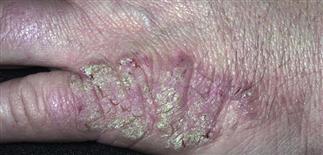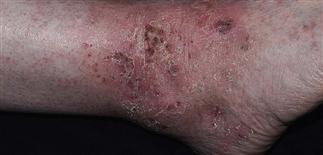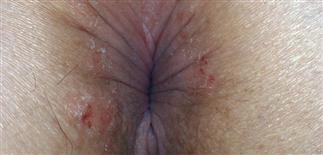Lichen simplex chronicus

Dorsum of the hand with an erythematous plaque that has overlying scale and fissuring. The skin is thickened in lichen simplex chronicus, often from chronic scratching or rubbing.

Erythema, scaling, marked xerosis, and angular erosions indicating excoriation characterized this lesion of lichen simplex chronicus.

The back of the neck is a common area for a plaque of lichen simplex chronicus. The patient often admits to repeated scratching of this area.

The perianal skin is thickened and pink, with fissuring, due to chronic scratching. Cool compresses, topical steroid ointment, and oral antihistamine should help interrupt the itch–scratch cycle.
DESCRIPTION
Localized plaque of chronic eczematous inflammation created by habitual rubbing and scratching. Frequently located on wrists, ankles, anogenital skin, and back of neck.
HISTORY
More common in adults but may be seen in atopic children. A typical plaque stays localized and shows little tendency to enlarge. Once established, the plaque does not usually increase in size.
PHYSICAL FINDINGS
• Findings include a sharply demarcated, deeply violaceous or red scaly plaque with prominent skin lines (lichenification). • Although this is a chronic eczematous disease, acute changes of vesiculation and weeping may result from sudden allergy to topical treatments. • Moist scaling, serum, crust, and pustules signal secondary infection. • Nodules, usually smaller than 1 cm and scattered randomly on the scalp, occur in patients who frequently pick at the scalp. • Areas most commonly affected are conveniently reached, commonly the outer portion of lower legs, wrists, ankles, posterior neck, scalp, eyelids, fold behind the ear, scrotum, vulva, and anal skin. • Infection can mimic lichen simplex chronicus; consider potassium hydroxide examination. • Contact allergy may cause, lead to, or complicate. Patch testing can be helpful.
TREATMENT
• Stress may play a role in some, and should be explored, acknowledged and addressed. • The patient should understand the problem will not resolve until even minor scratching and rubbing are stopped. • Scratching frequently takes place during sleep, and the affected area may have to be covered. • Treatment consists of a 5-min water soak followed by the application of a topical steroid with medium to high potency in an ointment base. • The treatment of the anal area, genitalia, or fold behind the ear does not require potent topical steroids; rather, these areas should be treated with low-potency topical steroids in ointment base. • For scalp lesions, apply a group I or group II steroid gel such as fluocinonide (Lidex) or a solution such as clobetasol (Cormax scalp solution) twice each day for 2 weeks. • Moist, secondarily infected areas respond to oral antibiotics and topical steroid lotion. • Nighttime itching can be diminished with oral antihistamines such as diphenhydramine (Benadryl) or hydroxyzine (Atarax). • Grenz ray (superficial X-ray therapy) can be helpful but has limited availability. • Nodules caused by picking may be very resistant to treatment, requiring monthly intralesional injections with triamcinolone acetonide (Kenalog 5–10 mg/mL). • Stress does not cause the condition, but most definitely contributes to aggravating and perpetuating it. Ask about stress, address the role it can play, and seek avenues for stress reduction.







